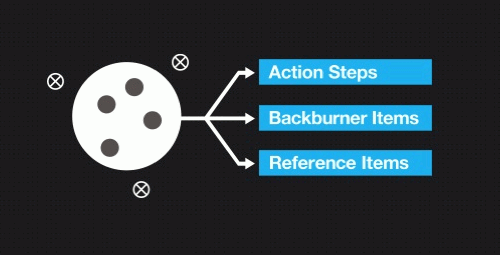How I Make Ideas Happen - 5 Tips
Some creative people and teams are able to defy the odds and make their ideas happen, time and again. In my work, I have spent the better part of five years meeting these exceptional people and chronicling their habits and insight, which has resulted in the following tips and suggestions for making ideas happen.
1. Avoid A Reactionary Workflow

Without realizing it, most of us have gradually adopted a “reactionary workflow.” We are constantly bombarded with incoming communication: email, text messages, tweets, Facebook posts, phone calls, instant messages, etc. Rather than be proactive with our energy, we spend all of our energy reacting, enslaved to the last incoming item.
To avoid this reactionary workflow, some of the most productive people I have met schedule what can be called “windows of non-stimulation” in their day. For two to three hours per day, these people avoid email and all other incoming communication. In this time, they focus on their list of big items: not routine tasks, but long-term projects that require research and deep thought.
Another idea is to aggregate all messages in a central location. Setting your social networks to email you, and using filters to automatically manage these emails, will reduce your “hopping time” (when you hop between sources of communication) and focus your attention. Some people even have their voice mails transcribed automatically and forwarded by email. In a world of many inboxes, you have to consolidate.
2. Strip Projects To Three Primary Elements

Every project in life can ultimately be reduced to just three primary elements: 1) action steps, 2) backburner items and 3) references. Action steps are tasks that can be articulated succinctly and begin with verbs. They should be kept separate from your notes and sketches.
Backburner items are ideas that come up during brainstorming or while on the run and that are not actionable but may be later on. Backburner items should be collected in a central location and revisited periodically as a ritual. One leader I met prints out his list of backburner items (which he stores in Word document) on the first Sunday of every month. He grabs the sheet (and a beer) and then sits down to review the entire list. Some items will be crossed off as irrelevant, some will remain on the list, and some will be transformed into action steps.
The third element of every project is references: the articles, notes and other stuff that collect around you. It turns out that references are overrated. Rather than spend hours organizing your notes, consider simply filing your notes chronologically (i.e. not by project or anything else) in one big file. In the age of digital calendars, we can search for any meeting and quickly find the notes taken on that date.
3. Measure Meetings With Action Steps

Meetings are extremely expensive considering the cost of time and interruptions they represent. Beware of “posting meetings” or meeting “just because it’s Monday.” Such meetings are usually scheduled for the morning—when you’re at your most productive—and often end without any action steps having been captured. A meeting that ends without any action steps should have been a voice mail or email.
When you do meet with clients or colleagues, end each meeting with a quick review and capture the action steps. The exercise should take less than 30 seconds per person. Each person should share what they captured. Doing so will almost always reveal a few action steps that were missed, duplicated or misunderstood. Reading your action steps aloud also cultivates a sense of accountability.
4. Reduce Your Insecurity Work

In the era of Google Analytics and Twitter, we spend too much time obsessing over real-time data because it’s all at our fingertips. Whether it’s your website’s traffic or bank account, checking these repeatedly doesn’t help make your ideas happen. They just make you feel “safe.” Insecurity work is stuff we do that (1) has no definable outcome, (2) does not move the ball forward in any way and (3) takes up so little time that we can do it multiple times a day without realizing it. Still, it puts us at ease.
The first step to reducing insecurity work is becoming self-aware. Identify the insecurity work in your daily life. The second step is to establish guidelines and rituals for yourself that create discipline. Perhaps you could try restricting all of your insecurity work to a particular 30 minutes every day? The third step, if applicable, is to delegate your insecurity tasks to a less insecure colleague, who can review the data periodically and report any concerns.
5. The Creative Process Is About Surviving The “Project Plateau.”

Everyone has their own approach to generating ideas. There’s no “best way” to be creative. But when it comes to the process of executing ideas, we all face one challenge in particular: sticking with it. Most ideas are abandoned at what I’ve come to call the “project plateau”: the point when creative excitement wanes and the pain of deadlines and project management becomes burdensome. To escape this pain, we generate a new idea (and abandon the one we were working on). This process can easily repeat itself ad infinitum, without us ever finishing anything meaningful.
Show your ideas some respect, and spend some energy improving how you execute. If not for you, do it for everyone else who will benefit from your ideas once they actually see the light.
You may also want to check out the following Smashing Magazine articles:
- How To Transform Your Problem-Solving And Creativity
- 20 Time-Saving Tips to Improve Designer’s Workflow
- The Process of Creativity
- Is The Internet Killing Creativity?



 Register!
Register!

 Flexible CMS. Headless & API 1st
Flexible CMS. Headless & API 1st


